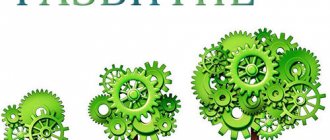System of exercises “Concentration of attention”
THE POWER OF CONCENTRATION IS EFFICIENCY IN ANY ACTIVITY!
That is why a person must have this most important skill. He is the key to all successful deeds.
Task:
the ability to manage your attention.
Why it's useful:
The ability to concentrate gives a person the ability to accomplish a much larger volume
your work, your business! It is interesting that trained attention increases not only the concentration itself, or in other words, the stability of attention, but also, as a consequence, such an important quality as attention span.
·Moreover, high concentration allows you to work not only with more quantity, but also with much better quality.
High concentration allows you to succeed in a variety of areas of your activity
and be much more successful than others. We have to admit that high personal effectiveness is impossible without full concentration on your task.
·The ability to manage your attention, in essence, possession of concentration and strong-willed qualities
- these are synonyms. If you have high concentration, it means you have a developed will. And vice versa. If you have developed strong-willed qualities, it means you have high concentration.
·Training develops not only physical muscles, but also mental ones. We can say that concentration is the “muscle” of our psyche, our willpower!
First, take the tests and find out your level of concentration
Science testing
You probably guess that psychology has already come up with more accurate tools, instead of bowls of oil, for diagnosing such an important mental function as attention. If you think that the bitter truth is better than a sweet lie, you can take the risk. We suggest you check your level of concentration, and if you are also a manager, the level of absent-mindedness of your subordinates. The three following tests of attention are the most reliable tests currently existing in psychology.
Munsterberg technique
is a solid alphabetic text, among which there are words. The test subject's task, while reading the text, is to find these words as quickly as possible. Two minutes are allotted for work. Before taking the test, print it out on paper, find a stopwatch, or ask a friend to be the judge. Each word found is underlined in pencil. After the subject finishes, the number of underlined words must be counted and compared with the correct answer.
bsolntsevtrgshoirionzshguchnewsheygchyafactsukexamrochagschg
Central Prosecutor's Office
zorboljshehuelgshchbmemoryshogeyuzhpzhpregschknoperceptionytsukengoizh
ъwafyproldblyubovyfprodspektaklyachsymtbyunbuerjoywufcieo
ldzhnarodoljdbshyrreportzhdorlafyvuefbyukonkonkursifnyuvskayaprry
personalityzheeyudshschgloginepppprswimmingliesliesprtcomedyboat
despairenfrlnyachvtjheftasenlaboratorygshdschiuctrrilontovaniyazh.
There are 23 words encrypted in this test. If you don't finish it in 2 minutes, it means you have a below average attention span. If you found all the words in 2 minutes, this is a good result. If you even have time left, this is an excellent result. If you find fewer than 23 words, then for each missing word you add a 5-second penalty (the threshold time is exactly 2 minutes).
Schulte tables
The table is a set of numbers (from 1 to 25) arranged in random order in cells. The subject must show and name all the numbers from one to twenty-five as quickly as possible. You can record the numbers only with your eyes or with a pen, but do not leave marks. Five tables are provided for five attempts. The time spent on this work must be recorded.
Evaluation of results.
- Concentration of attention is at a good level - if no more than 40 seconds are spent on each of the tables.
- Concentration of attention is at a sufficient level - if no more than 50 seconds are spent on each of the tables.
- Concentration is weak - if more than 50 seconds are spent on each of the tables.
“10 words” technique
This test is based on the close connection between concentration and short-term memory. The subject is read ten random words, selected without obvious semantic or associative connections. After a single reading, you are asked to reproduce all the words in any order. If you work independently, you need to read ten words only once, carefully reading each concept, and reproduce them by bending your fingers.
There are 5 sets of 10 words (for five attempts).
1.Book, rose, domino, yacht, rabbit, glasses, brick, nest, needle, double bass.
2. Swamp, prince, cat, shop, desk, football, cloud, jellyfish, picture, thermometer.
3.Axe, thunderstorm, wine, armor, zoo, samurai, factory, weight, baron, ore.
4. Cinema, apple, teapot, miracle, rhinoceros, October, finish, brush, grain, paper.
5. Cabbage, sword, pillow, road, saw, hill, fence, pipe, wedding, mosquito.
Evaluation of results.
Concentration is good if after one reading you can reproduce 8 or more words. Concentration is satisfactory if you can reproduce 7 words. Concentration is weak if you can reproduce less than 7 words.
Exercises for training
1.The first series of exercises on “Concentration”
These are exercises to increase the degree of composure of the individual, to develop and test voluntary concentration.
OZR:
performing 5 times in a row, this exercise is 95%.
How I will work:
· I choose the exercises I like for daily training from the list below.
· Printed them out. I carry it with me. I train for 5-10 minutes at any time.
·I exercise 5 times a week, 2-3-4 times a day for 10 minutes (for advanced and monsters 20/30 minutes), before lunch and after.
Exercise "Line"
The task is to draw a line on a blank sheet of paper using a pencil, very slowly and smoothly, and focus all your thoughts and attention only on it. As soon as you catch yourself being distracted, make a small peak upward, like on a cardiogram, and continue. Based on the results, it is not difficult to calculate the number of distractions. A good level of concentration if there are no peaks in three minutes.
Exercise "Colorblind".
Despite its apparent simplicity, this is a rather complex exercise. Say out loud the colors of the words as you read the following colored text. It is the colors, not what is written.
It’s good if after training you basically managed to do this without errors.
Exercise "Fly"
Imagine a tic-tac-toe board. Three by three. A fly sits in the central field. The goal is to move the fly so that it does not go beyond the edges of the field, and without losing it with your focus. There are only four moves - “up”, “down”, “right”, “left”. The fly does not move diagonally, the fly does not reverse - this is considered a mistake. Of course, you cannot move a fly solely mentally, or draw a field on paper - the game loses its meaning. It’s more interesting to play with two or three or more, but it’s more difficult to play alone. If you lasted five minutes without making mistakes, this is a good level of concentration.
Exercise “Two flies”
A more difficult version of the previous exercise. There are two flies on the field - fly one and fly two. The flies walk in turns, for example: “Fly one - up”, “Fly two - to the right.” The rules and task are the same: mentally don’t lose flies and don’t make mistakes. Three minutes without errors is a good result.
| 2. Second series of exercises on “Concentrating attention” |
*Reflection is a condition for consciously managing your attention and your life.
| Reflection is the ability to see and be aware of not only the direction of attention, but also of your psychological state, thoughts, feelings, sensations. This is the ability to observe oneself as if from the outside, as if an outsider were observing it. This is the ability to see exactly where your own attention is, where it is directed. An unreflective person lives, floating with the flow - wherever it takes him. Reflection helps the individual understand where he is, what he is doing, and what needs to be done next. The best way to learn life awareness is undoubtedly from the greats. From the diary of L.N. Tolstoy, entry on March 1, 1897: “I was wiping the dust in the room, and, walking around, came to the sofa, and could not remember whether I had wiped it or not. Since these movements are habitual and unconscious, I felt that it was no longer possible to remember. So, if I wiped it and forgot it, that is, acted unconsciously, then it’s the same as it didn’t happen. If someone had seen more consciously, it could have been restored. If no one saw or saw, but unconsciously; if the whole life of many passes unconsciously, then this life would not have happened.” LEARN TO SEE WHERE YOUR ATTENTION AND YOUR ENERGY ARE DIRECTED! Exercise “Where my attention is directed” From time to time ask yourself:
In order to remember to do this, it is useful to hang several of these questions from this list in large letters in front of your eyes. You will involuntarily remember them and control your resources and attention. Learn to see yourself! OZR: Always, at the beginning and in the process of any business, I automatically answer the questions described above. How I work: ·I write out questions on stickers of different colors. · I hang it in visible places, refrigerator, computer. Mirror and others, I’ll think about it much better... · 2 times a day I answer myself with a complete list of things that I am doing at the moment. Exercise “Reflective Reading” Have you ever controlled your own reading process? Have you noticed that you often run your eyes over the lines, but your thoughts are somewhere else, already thinking about something extraneous? Attention is a capricious thing, and especially with weak concentration, a person is constantly distracted, and even then cannot remember what he read about. The efficiency of such reading is, of course, low. Careful reading involves capturing not only the general meaning, but also all the depth embedded in the text by the author, all the details and nuances - of course, if this is not a newspaper for speed reading or pulp detective fiction for killing time. It makes sense to train in this exercise on non-empty material, on books that are worthy of being read into and seeing the depth in them. The exercise consists of fully concentrating on the text, completely immersing your attention in it, reading every line without distraction, searching and finding everything that the writer has included here. Read at a comfortable pace, do not set records, but set the task of thinking about all the meanings and nuances. At the same time, part of the focus is on self-reflection. If you notice that you are distracted, you turn on your volitional qualities and again direct your attention to the main task. The exercise is reminiscent of the exercise with the second hand, only instead of what is interesting about the arrow, you look for what is interesting about the text. If you have enough strong-willed qualities and concentrated and reflective reading becomes a habit, you will be able to see more in any text than ordinary readers see, perceiving books with half an eye, like entertainment on the subway. ORR: read the text for 15 minutes without a single distraction from the text. How I will work: • 5 times a week, 1 time a day I read for 15-20 minutes (for monsters 30 minutes) with full concentration. • I count how many times I was distracted and put down my chopsticks. I keep an eye on the statistics. I compare how many distractions there are at the beginning of the week and how many there are at the end. • At the end of the week, I write successes in my success journal. 3. The third series of exercises on “Concentration of attention” |
Emotional balance
Why it's useful:
Minuses:
Emotions, like any anxiety, significantly interfere with controlled concentration. In an excited state, a person is unable to concentrate on anything. Strong anxiety during public speaking deprives a person of any remnants of memory. Irritation blocks constructive thinking. A stressful state deprives a person of the ability to control himself. Mental or physical pain prevents a person from performing even everyday activities.
Pros:
Only in a balanced state are we fully able to direct the focus of attention without loss to distractions.
An indicative example is the already mentioned people of choleric temperament, as people with the highest level of emotions, concentrate their attention on any objects for an extremely short time, in order to again switch to the next object. Therefore, I recommend that choleric people work on achieving emotional balance, reducing the emotional background, using the exercises below, first of all. This will allow them to level out the weak points of their temperament and better use the strong ones (agility of mind, high energy, artistry).
For people of other (“normal”) temperaments, a tactical reduction in the level of emotions is recommended in especially significant situations - before an important conversation, exams, business negotiations, an important meeting - this is a warm-up and internal concentration. So are we, even if not all are athletes, but in our field, I hope, we are all professionals.
It is best to focus on simple but effective exercises for emotional balance, increasing composure and increasing concentration. Then, during the negotiations themselves, your thinking and attention will work one hundred percent and you will show all your best qualities.
OZR: I can concentrate on one object and think only about it for 3-5 minutes.
How I will work:
· I select exercises from those listed below, in pairs and apply them 1 time per day (1 pair per day, work 5 times a week). One in the morning, the second in the evening.
·I am looking for material for exercises: a picture of nature, I buy a rosary.
· At the end of the week I write down my conclusions and successes, which exercise works well and can no longer be done, and which one still needs to be worked on for 2-3 weeks.
Exercise "Breathing"
This is a good exercise not only for increasing concentration before an important task, but also for quickly eliminating unnecessary anxiety, for example, before a public speaking. Breathing a little more deeply, concentrate on the breathing process. Watch in detail with your mind's eye how the air penetrates through the respiratory tract into your lungs, slowly filling and expanding them. And then, after a pause, it leaves just as slowly, passing in the opposite direction. Lead time depends on circumstances. Work for 3-5 minutes.
Exercise “The surface of the lake”
Particularly effective for reducing excess emotionality and internal focus. Imagine in your mind's eye the absolutely quiet, windless surface of the lake. The surface of the lake is completely calm, serene, smooth, reflecting the beautiful shores of the reservoir. The water of the lake is mirror-like, clean, smooth, reflecting the blue sky, snow-white clouds and tall trees. You simply admire the surface of this lake, tuning in to its calm and serenity. Work for 5-10 minutes, you can describe the picture by mentally listing everything that is drawn on it.
Exercise "Rosary"
An ancient oriental way of focusing and eliminating disturbing thoughts. Slowly finger the rosary, fully concentrating on this activity, directing your focus only to the process itself. Listen to your sensations in the area of contact with your fingers and immerse yourself in them, achieving calmness and awareness. If you don’t have rosary beads, you can replace them by twisting your thumbs. Cross your fingers together, as many people do in thought, and scroll your thumbs, concentrating only on this process.
Exercise "Film Reel"
On internal concentration and ordering of emotionality. Imagine that you are watching a video recording of today (or yesterday) of your life - from the side, like in a cinema hall. Remember in all the smallest details how your day went. How they got up, what they did in the morning, prepared to leave the house, how they left, what were the small and significant events of the whole day, with whom and what they talked about, what happened in the late afternoon. Remember carefully and in detail, trying not to miss a single picture. If an important meeting or negotiation awaits you now, once again mentally scroll through the most important, key points and positions on which you will build your conversation.
Exercise “Mental Relaxation”
Sit on a chair (armchair) comfortably, but as straight as possible, leaning on the back. With your inner eye, begin to view and relax the parts of your body to which you direct your mental focus. First, direct your attention to the very bottom - to the foot of your right foot, stop on this area for a few seconds, with an internal order, completely relax it, rise higher. Next, fix your attention on the calf area of your right leg, completely relax. Next, go up to the knee area, feel and relax it. Higher. Next is the left leg. Then the genital area. Abdomen area. Chest. And so on. Slowly, with minimal upward movement. Achieve complete, consistent relaxation of all areas of the body, but without falling from the chair, minimal control still remains. This is a good way not only to train concentration, but also to relax without being noticed by your surroundings. This exercise usually takes 5-7 minutes.
Exercise "Sphinx"
Despite its apparent simplicity, this is a more difficult exercise than the previous one. It is necessary to be absolutely calm on the chair, completely motionless, without moving, stopping any involuntary muscular movements. The state is relaxed, there is no need to strain. Let go of your thoughts, allow them to come and go in a relaxed manner, without specifically directing them anywhere. It’s good if you achieve a comfortable, motionless state of the wise sphinx within 15 minutes.
Exercise “Sculpture”
If you have been to Europe or seen it on TV, you have seen on the tourist streets people in special paint who work as living sculptures. Often these are actors whose developed concentration allows them to remain motionless in difficult positions for quite a long time. God forbid you work as a dummy, but this is a useful exercise for testing and developing voluntary concentration. The simplest level is a regular upright pose. If you can do it in a state of complete immobility, but in a relatively relaxed comfortable state, 10 minutes is a good result. Complicate the pose - raise your arms, tilt your head, turn your body and again achieve complete immobility. It is clear that the more complex the pose, the more difficult the exercise and the shorter the control time. The disadvantage of this exercise is that it can only be done in public once - before the ambulance arrives.
Concentration Summary
Within 2 months, after such training, a person begins to retain all possible parameters in his attention span. Would you say it's hard? And for whom is it easy? It’s hard to learn, it’s easy in the affected area... More K.S. Stanislavsky said to his actors when they were lazy:
GENIUS IS ONE PERCENT TALENT AND 99 PERCENT WORK!
There are many talented people - but no one will ever recognize this talent without the ability for high concentration and dedication. And these 99 percent of work are possible only with developed concentration.
It is attention that gives direction to human strength, focuses it. The same great director never tired of repeating:
WHERE IS ATTENTION, THERE IS ENERGY!
And where there is energy, there is force applied, and where there is force, there is the result.
WHERE THE ENERGY IS, THERE IS THE RESULT!
CONCENTRATION OF ATTENTION IS THE ABILITY TO DIRECT AND KEEP YOUR ATTENTION AND CONSCIOUSNESS TO ANY OBJECT, EVEN UNINTERESTING
Good luck!
Note: The material is based on materials from psychologist and speaker Dmitry Ustinov.
Here you can get as much information as possible on this topic //www.ustinow.ru/publication/sila_koncentracii/index.html
Attention span
When studying attention experimentally, its volume . This is the number of unrelated objects that can be perceived simultaneously, clearly and distinctly. In an adult, the volume of visual attention is 3-5 (rarely 6) objects. Junior schoolchildren have 2-4 objects. The volume of auditory attention is usually one less. Training only stabilizes the results at the upper limit. However, the amount of attention also depends on familiarity with the material and interest.
Sustainability of attention
This is the duration of concentration of consciousness. What does it depend on? When the object of attention does not provide new impressions, attention is distracted from it. Consequently, attention can be maintained only by constantly revealing new content in the object of attention.
Georges Cuvier claims that genius is first and foremost attention. He writes that an intellect that is poor in knowledge, immobile and unoriginal, is unlikely to be able to focus its attention on one subject for long. Therefore, we can say that it is not attention that creates a genius, but genius allows one to maintain stable attention and find more and more new aspects in familiar things.
Switching attention
It differs from distraction in that it is performed by a person consciously. Therefore, a simple transfer of attention to another object cannot be considered a switch: it must be associated with setting a new goal. Initially, it was believed that the ability to shift attention was innate and available to few people. Later it was shown that special training can improve attention switching.
With a high concentration of attention, switching it is difficult. This leads to absent-mindedness, which comes in two forms.
Firstly, there is an inability to concentrate attention for any length of time - it constantly “slides”, a person is constantly distracted. One of the reasons for such absent-mindedness may be an excess of all kinds of shallow interests.
Secondly, there is absent-mindedness as a one-sided concentration of consciousness, when a person does not notice what, from his point of view, seems insignificant. A classic example is the absent-mindedness of a scientist who is absorbed in his work and does not ignore the various “little things in life.”










